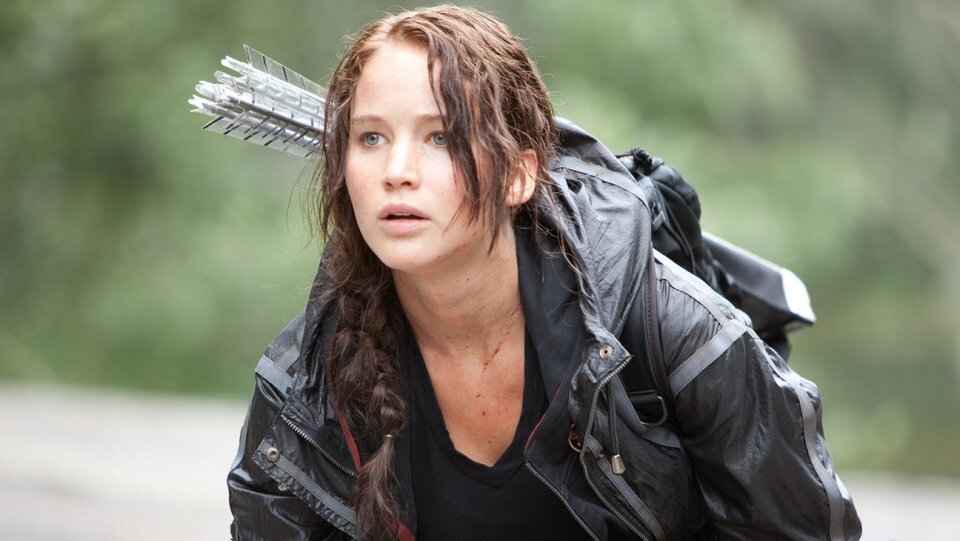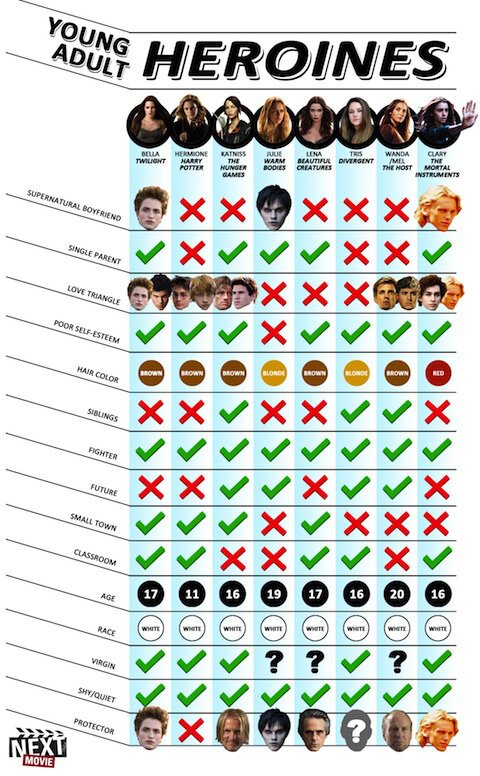All Female Protagonist Are The Same
Women characters are not treated or talked about as though they could have the same range as men. I answered the question “How is Clary different from Katniss and Bella?” so many times at Comic Con that I finally blew up at some poor guy and said “Andrew Garfield is right behind me on the carpet. Are you going to ask him how Spiderman is different from Harry Potter? I mean they both fight evil, right? So GO AHEAD AND ASK. Ask Robocop, too, while you’re at it.
This is YA author Cassandra Clare, speaking about the way the media has approached the first movie adaptation of her series, The Mortal Instruments. I know people have very varied (and very intense) views on Clare herself and on her books, but regardless of your opinion of her, she makes an important point here. On the rare occasions that a female character leads a non-"chick flick" movie -- a movie with action, or dragons, or robots, or vampires, or whatever -- she is constantly compared to every female lead before her, as though they have to prove their uniqueness. We've already seen a girl as a protagonist, the critics seem to say. What more can this new character have to offer?Her words are powerful on their own, but they also reminded me of a chart I saw a couple of weeks ago on Upworthy, which lays out the similarities and differences between each female lead of recent and upcoming YA adaptations.
It's meant to be a critique of how female characters are all the same. Instead, it itself becomes a glaring example of the way the media attempts to put female characters into boxes, and the way it imposes expectations about female characters and narratives onto the stories themselves.
Normally, Upworthy is a pretty darn good site. But they've taken a chart that was originally designed to allow people to see the differences between these heroines (which is still problematic in itself) and instead claimed that this shows they are all the same. One glance at the chart shows that isn't the case. Some have parents who are together, some have parents who divorced, or who were never married, or who are dead. Some are single, some not. Some had siblings, some not. Some are from the future, some are from fantasy lands, some live in small towns... all this chart does is show that there are actually a wide range of characters, with a wide range of stories and backgrounds.
There is one very important, very valid criticism lying in there: all of these girls are white. Even Katniss, who has ambiguous ethnicity in the Hunger Games books, had a "white women only" casting call for the movie adaptation. But people aren't talking about that. They're instead talking about and criticising the similarities between their personalities and situations, similarities that don't actually exist. But its better to criticise love interests than racism, right?Because then we get into the inaccuracies, born straight out of what the media expects from female characters. Can anyone who's read the Harry Potter books (or seen the movies) really say that Hermione is caught in a love triangle? Sure, fans imagined different relationships for Hermione, but Hermione herself never expresses any feelings for Harry, and he never expresses any feelings for her. Yet she's a female character with two male allies, and so she must be a love triangle with both of them, right? The Mortal Instruments is a less well-known example, but again, it doesn't actually have the love triangle that this chart wants it to have. Simon may like Clary, but she never thinks of him as anything other than a friend. She may play with the idea of dating him when the person she really loves, Jace, seems out of the picture, but the only reason anyone would call it a love triangle, rather than a friendship with some complications, is that we expect teenage protagonists to be caught in love triangles, to the point that we almost force one on them.
Next, the chart tells us that every single female character, sans Julie from Warm Bodies, has poor self esteem. Do they? Do they really? Does Hermione, who has every faith in her own intelligence, who sticks up her hand in every class, starts her own social campaigns and will stand up to her friends, have low self-esteem? Does Katniss, a girl who puts her life on the line to save her sister? What about Tris, a girl who's willing to leave her family behind to live where she feels she really belongs, stand up to bullies, and ultimately fight to save the people around her? And I'm not sure that "low self esteem" really fits into Clary Fray's battles with demons. And we see the same thing with the "shy/quiet" category. Apparently all these girls are shy/quiet, including no-nonsense Katniss and outgoing Tris.
Having low self esteem isn't a bad character trait. People do have low self esteem, and so some characters should as well. But claiming that every female character is, in order to create a narrative about how female characters are whiny and weak? No.
The chart then informs us that all of the girls are fighters. This one is closer to the truth, but its a massive oversimplification. Bella doesn't fight until the final installment of her saga, when she becomes a vampire. Hermione is a witch, but Defense Against the Dark Arts is her worst subject, and she is terrible under pressure. She fights to defend herself when necessary, but the ability to fight isn't her defining trait. In the end, she's not even that good at it. It's not where her true strengths lie. Once again, the media has forced its image of what female characters are like onto the characters themselves, without any reference to nuance, or even to reality.
In the end, the message is one that undermines female characters, their variety and their importance. All these female characters are the same, it says. They're one-dimensional"badass fighter" yet "shy loner" girls, enjoyed by similarly shallow viewers. Each one has to fight for her right to exist, because female characters have already been done, and hey, if they're all the same, why bother to create more? Why have them at all, when there are more male characters to be watched?
Upworthy might have been attempting to comment on the dearth of good female characters in the movie business, but this is not the way to go about it. Some of these protagonists are pretty problematic (Bella in particular) and could be subject to legitimate criticism, but they not all the same. Let's talk about the nature of their relationships and characterizations in these movies. Let's talk about the fact that there's no racial diversity whatsoever. Let's talk about anything except how they're all the same. And if we must talk about that, let's talk about how the media expects all female characters to be the same, rather than criticizing the characters and writers for similarities that don't even exist.






























